Instantiation Read online
Page 37
10
“We’re making plans to launch an ark that will preserve our civilization.”
Fatima’s heart sank as she heard the words, and she resolved to ignore them and keep loading the dishwasher, but Salif called out to her, “You’ve got to see this!”
Reluctantly, she joined him in the living room. A caption described the interviewee as George Fletcher, the director of a British think tank called the Institute for the Future.
“You don’t think that’s an alarmist response?” the interviewer asked.
“Not at all. The Pane continues to grow, and every chance it’s had to show itself to lie further away than some star, it’s turned out in fact to be closer. We’re now certain that it’s less than fifty light-years away, but that figure only keeps falling. Whether the Earth is at risk of being damaged or merely captured by some hostile entity is unclear, but we need to be prepared for the worst.”
“But what kind of spacecraft could we build at short notice? Where would we be sending it?”
Fletcher nodded gravely. “It’s a terrible thing to have reached this point, because even with the largest investment of resources we could hope to muster, we’ll only be able to send a robotic craft, carrying a digital library and some frozen genetic material. To out-race the Pane, we’ll launch it in a direction that will optimize its chance of escaping; once it’s achieved that goal, it will need to be able to carry out its own search for a potential new home.”
The interviewer frowned slightly, but remained professional. “Is this a serious plan? Is NASA involved, or the ESA? China’s CNSA?”
Fletcher said, “So far, we have more than a dozen philanthropic backers, all people with considerable wealth. Of course we’d prefer to have the government space agencies on board, but if the politicians can’t be brought to their senses, we’re prepared to work solely with commercial launch partners.”
Fatima flopped down onto the sofa. Was this where the panic was going to start in earnest – with a cabal of gullible tech billionaires? Followed by everyone whose gametes wouldn’t be on board the life-raft railing against the injustice of their own genetic annihilation? There might even be a frozen brain or two tucked away in the cargo, so the descendants could resurrect their benefactors after planet-fall … or maybe that would just be the rumor that helped drive the mobs to burn everything down.
“Turn it off,” she begged Salif. He clicked the remote.
“People ask me questions,” he said. “Colleagues, friends. Some of them are genuinely frightened. I tell them everything the way you explained it to me, but they still wonder if you might be wrong.”
“Of course I might be wrong,” Fatima replied. “But if the Pane is dangerous, and it’s about to hit us, our chances of building anything fast enough to get away from it are approximately zero. If it wasn’t moving at light-speed, then it’s moving, or growing, so close to light-speed as to make no difference when it comes to escaping. We’ll all go together if we go.”
She let Salif switch the TV back on, but the Pane wasn’t finished with her yet. A religious leader in a town in rural India had managed to whip his followers into a frenzy over the supposed divine significance of the Pane, and nineteen people had died in the subsequent clash between rioters and police.
The last few times something similar had happened, Fatima had tried telling herself that if it wasn’t this, the same zealots would have found a different pretext. But the Pane was unmissable in the sky for half the planet, and it was only going to grow more prominent. So long as there was no consensus about what it was, and what it might mean for the Earth, to hope people would ignore it and just get on with their lives was too much to ask.
“The truth will make itself known,” Salif proclaimed earnestly.
“It will,” she agreed. “But maybe not soon enough.”
11
As Fatima crossed the common room and approached the coffee machine, she had to force herself not to lower her gaze. None of her colleagues were staring at her; no one was whispering or laughing. Even if they thought she was foolhardy for taking a position on the Pane – and even if they viewed her own theory as deranged – she knew they’d be polite enough to ensure that they betrayed no sign of it in her presence.
As she carried her mug toward the nearest table, someone approached her. “Excuse me, Dr Benga?”
She turned. It was Rob Bayer, from the galactic black hole group.
“I just wanted to say, I thought your paper made a lot of sense. Jolliffe’s wrong; the Pane can’t be spherical. This guy invents six new scalar fields before breakfast just to make his models work.”
Fatima smiled. “Thanks for the vote of confidence.”
Rob said, “I heard a group’s using the Hubble to get a deep field between the stars.”
“Between the…?”
“Between the stars through the Pane. They’ve found a small region where they think they can see past the local stars, and get a background showing a patch of distant galaxies.”
Fatima felt the skin on her forearms prickling; it was like the scene in a movie where the police were watching the video of a kidnap victim, and they spotted a reflection that let them look out through a window onto the street. “Which group?”
Rob hesitated. “I shouldn’t really say. They haven’t announced any results yet, and I heard about the whole thing third-hand. But I thought, if you had a heads-up, you might be able to use it.”
“Thank you,” Fatima replied, reflexively; she had no idea what he meant. But as he nodded and walked on, she understood. A correct prediction about the nature of this image, made before its actual contents were known, might win a lot of support for her model.
She sat down at the table. How long did she have? She thought of going after Rob to ask exactly when the results would be made public, but if he’d known that he would have told her. So she took a sip of coffee and tried to focus.
Suppose Jolliffe was right, and the Pane was a spherical wormhole. Since it wasn’t accompanied by a haze of gamma rays from interstellar hydrogen converting to antimatter and annihilating, it seemed safe to assume that it was not transforming objects into their mirror image. But since light entering a wormhole was essentially reflected away from it – albeit at the other mouth – points on the two mouths needed to match up with each other via a process that also included a reflection, so the two reflections canceled and the handedness of any traveler remained intact.
For a spherical wormhole, that still allowed an infinite number of possibilities, but Fatima could imagine two especially natural choices. Each point on one mouth could match up with the antipodal point on the other – in which case, the view looking through the Pane would show the galaxies that used to be visible in Octans, but they’d be rotated 180 degrees around the center of the view. Or, if the mouths had been born together, they might be mirror images of each other: reflections in the plane perpendicular to the axis along which they’d separated. The result would then depend on the relationship between the Earth, the Pane, and that unknown axis.
So, it would be hard for Jolliffe to predict the view. But how much did her own model change that? If the Earth really had passed through the Pane, they’d be seeing the distant galaxies directly, with nothing to distort or redirect the light – but by crossing through, the Earth itself could have been shifted into a new orientation.
If the two mouths of the Pane were disks traveling at light-speed, the simplest account of their birth would involve them fleeing the scene in opposite directions. But if that was the case, the disks could not be matched to each other’s mirror image in the axis of separation; that would imply that an object that passed through the leading face of one disk would emerge from the leading face of the other. Nothing could emerge from a portal that was traveling forward at the speed of light.
Fatima could see no other fix than to add in a rotation by 180 degrees: first reflect each disk, then turn it around, so the leading face was matched with the trai
ling face of the twin. But turn it around what axis? Anything perpendicular to the direction of travel would suffice … but how would nature have made that arbitrary choice?
The more she thought about it, the more troubling it seemed. It was true that she had no idea how these disks could have formed in the first place, so she had nothing more than a vague sense of symmetry to guide her. And the direction of travel would be arbitrary too, even if the pair of disks neatly canceled out each other’s momentum. But the need for an extra choice, plucked out of the vacuum, still felt wrong.
She could announce half a prediction, regardless: that the view between the new stars would look backward, away from Octans. It was hard to see how that part could be wrong – and if she was right, for Jolliffe’s model to explain the same result would require a blatant appeal to coincidence.
Fatima drained her mug and looked across the room. She had no doubt that people were discussing the Pane at every table, but for every supporter she had, and every detractor, she suspected there were ten others waiting for more evidence before they made up their minds. She’d started out just as cautious and agnostic, refusing to claim anything more than the observations showed. If she offered a prediction about the deep field now, it would just be a gamble – and if she was right, it would prove nothing more than that she’d made a lucky guess.
When she arrived home, the TV news showed no signs that the wormhole fever was subsiding. A fresh group of con artists were offering to “digitize” people and transmit them into space, which admittedly circumvented the problem of sluggish spacecraft escaping a relativistic threat, but didn’t inspire much confidence in the content of the transmission, let alone the ultimate fate of the data. Minor cults with their own idiosyncratic messages about the Pane were blossoming across the world, but Fatima was more worried about the people who’d ignore all the faux-rationalist and faux-religious nonsense and just look into the sky in search of answers themselves. Before long, their guts would tell them – quite reasonably – that something huge was sweeping toward the planet.
Salif said, “Didn’t everyone’s ancestors freak out at a solar eclipse, at some point? But I’ve never heard a historian attribute a serious cultural setback to an eclipse.”
Fatima took no comfort from that. “Eclipses only last a few hours. This could take a couple of years to resolve.”
Salif frowned. “And your nemesis has no qualms about spreading hysteria?”
“Jolliffe?” Fatima shook her head. “I can’t put the blame on him. He’s never claimed that the Pane will reach the Earth; all his calculations end up with the expansion slowing down and reversing. He believes that whatever’s happening here has happened at random all over the universe for the last thirteen billion years. His wormholes can’t grow forever, or the whole place would be like Swiss cheese.”
Fatima’s phone rang. It was Gabrielle, and she sounded excited. “Did you hear about the deep field?”
“No.” Fatima felt a pang of guilt; she hadn’t shared the early tip-off with Gabrielle, telling herself it wasn’t fair to burden her with it. But she was a grown woman, she could have made her own choice.
Gabrielle explained the part Fatima already knew, but then she added the revelation that had prompted the call.
“What it shows is that the background’s unchanged! All the galaxies we can see are exactly where they were before the Pane appeared!”
12
Fatima surrendered any hope of sleep. Salif offered to stay up and cook for her, to keep her energy from flagging while she worked, but she persuaded him to go to bed, leaving the house in silence.
Jolliffe’s model was mortally wounded. It wasn’t impossible for various aspects of the geometry he’d championed to conspire to yield an unchanged view, but no one could really argue for that with a straight face.
Nonetheless, her own theory still sat uneasily with the result. To explain it, she’d need the two disks to be traveling in the same direction. This scenario did avoid the awkward extra rotation, allowing the disks to be identified with nothing but a reflection – which canceled out the reflection at the boundary, and meant a traveler would pass through with their orientation entirely unchanged.
But how could two disks, born together, moving in the same direction at exactly the same speed, end up separated by thousands of light-years?
Not born together, then? But how had they become connected if they didn’t share a common origin?
Fatima put on a jacket and crept out into the courtyard, closing the back door as quietly as if she were sneaking out of her parents’ house for a forbidden night on the town.
The circle that everyone still called the Pane was wider than the Large Magellanic Cloud now, brighter overall but more visibly threaded with dust and gas. Above the crowded plane, just below the rim of the circle, the stars began to thin out; that was where the Hubble had found a place to peer into the background.
But even the foreground was more distant than the usual view: Gabrielle’s results had put all the Cepheids at least fifty thousand light-years away. As far as anyone could tell, there were no stars closer than that. If they were looking at a part of the Milky Way, they might well be looking at it from the outside.
But from where, exactly? If the two disks were sweeping through space on parallel tracks, what had set the two tracks apart?
Fatima pictured the cylinders the disks traced out in space-time. She shifted them back and forth in her mind, trying to imagine the perfect configuration – the one that nature would have chosen, because it could not have chosen differently. Were they side by side, keeping pace with each other? Or was one disk following the other, chasing it but never catching up?
For the rotation that she’d thought she’d needed to align the faces of the disks, there had been no right answer, no natural choice – because there’d been no rotation at all. But maybe she’d been wrong to think that the resolution there had left her with an entirely new problem. Maybe the answer was exactly the same as before.
She returned to her office and started collecting the software she needed. People had already written most of the modules she required; she just needed to fit them together. One piece of code mined the star catalogs from the Hipparcos and Gaia satellites, finding the most up-to-date measurements of current locations and proper motion. Another turned the mass of stellar data into a view from an arbitrary viewpoint, at any specified place and time. And a third module checked that synthetic view against the latest image of the stars from the Earth’s new vantage.
She took a guess to set the starting point for her extragalactic hunt, then she unleashed the search algorithm. It was not a fast process; each iteration had to find the best matches between millions of stars. But she’d narrowed down the degrees of freedom to a single parameter, and over forty minutes, she watched the program converging on an answer.
When it halted, having done its best, the artificial image and the real one, though easily distinguishable by eye, were eerily close. Not every star had been cataloged and measured, and not every measurement was perfect. But by following the Pane along its trajectory into the future, the algorithm had found a viewpoint that more or less matched what Fatima now saw in the sky.
There was no need for a second disk, on a second, parallel track. If you passed through the leading face of the Pane, you emerged from the trailing face of the very same disk … after a delay. The past and future hyperfaces of the cylinder that the Pane traced out through space-time had somehow slipped along their shared boundary, so although they remained in intimate contact, they no longer matched up in the same way. It was less like any kind of bridge or tunnel than an ancient fault line, worn so smooth that you could cross it without ever noticing that the strata had ended up wildly misaligned.
Fatima shut down her computer, turned off the lights and walked quietly to the bedroom. When she slid under the covers she put her arms around Salif and held him tightly, clinging to his warmth.
He stirred. “Did
you get anywhere?” he asked.
“I did. I’ll tell you all about it in the morning. Right now I need to catch some sleep.”
“Good idea.” He took her hand and covered it with his own. “Do you know what time it is?”
Fatima said, “About 65,000 AD.”
13
“I have an idea,” Gabrielle announced. “I think there’s a chance we can clinch the argument, once and for all. But it’s going to need a coronagraph. In space.”
Fatima said, “I’m listening.”
The plan made sense to her, but they’d need time on the James Webb telescope. Fatima started sending out emails, trying to recruit supporters for the proposal, far from sure of her chances of success. Though everyone she knew in the exoplanet community had accepted her model of the Pane, that could only have increased their sense of urgency to use the Webb for its original purpose, in the short time that remained before its planetary targets all went out of range.
Jolliffe had gone quiet, but other wormhole proponents remained stubborn. The fact that they could gaze into the southern sky and see the Milky Way as it would appear 63,000 years into the future, from 63,000 light-years away, was not enough to convince them that they’d actually crossed that interval of distance and time themselves. Wormholes could be turned into time machines, so they might be looking at light streaming back to them from the future. The Slipway model explained the same observations without violating causality; stepping through the Pane carried you across a vast stretch of space and time, but you did not travel faster than light, and you could not turn around and step back into the time you’d come from.

 Zendegi
Zendegi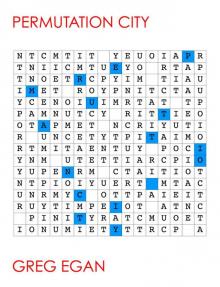 Permutation City
Permutation City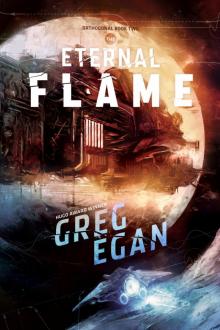 The Eternal Flame
The Eternal Flame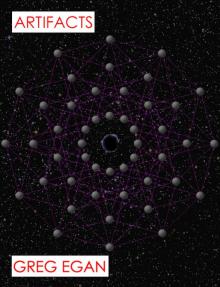 Artifacts
Artifacts Wang's Carpets
Wang's Carpets Dichronauts
Dichronauts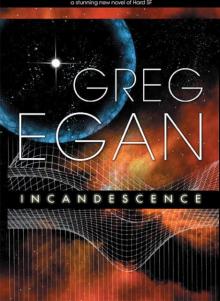 Incandescence
Incandescence Teranesia
Teranesia Schild's Ladder
Schild's Ladder Quarantine
Quarantine The Four Thousand, the Eight Hundred
The Four Thousand, the Eight Hundred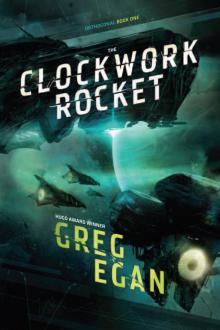 The Clockwork Rocket
The Clockwork Rocket Zeitgeber
Zeitgeber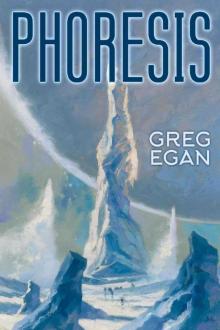 Phoresis
Phoresis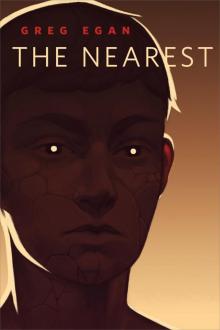 The Nearest
The Nearest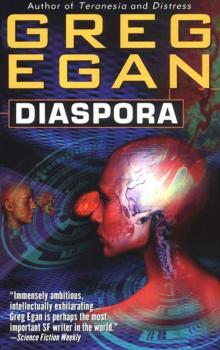 Diaspora
Diaspora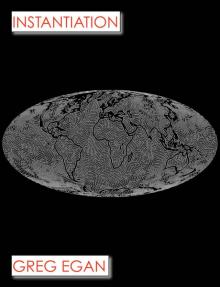 Instantiation
Instantiation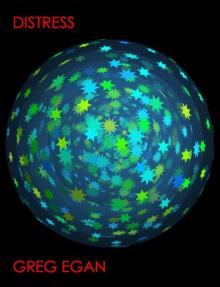 Distress
Distress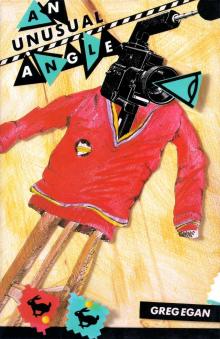 An Unusual Angle
An Unusual Angle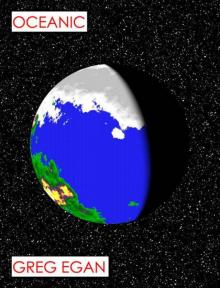 Oceanic
Oceanic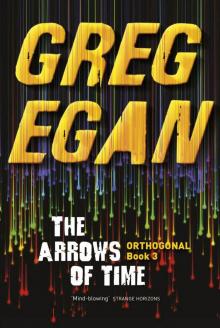 The Arrows of Time
The Arrows of Time Axiomatic
Axiomatic![Anthology 2. Luminous [1998, 2010] Read online](http://i1.bookreadfree.com/i/03/18/anthology_2_luminous_1998_2010_preview.jpg) Anthology 2. Luminous [1998, 2010]
Anthology 2. Luminous [1998, 2010]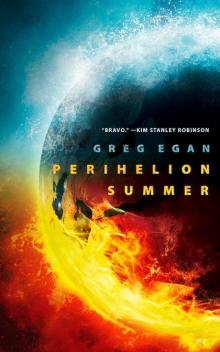 Perihelion Summer
Perihelion Summer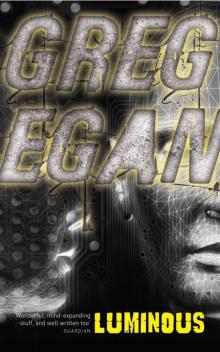 Luminous
Luminous